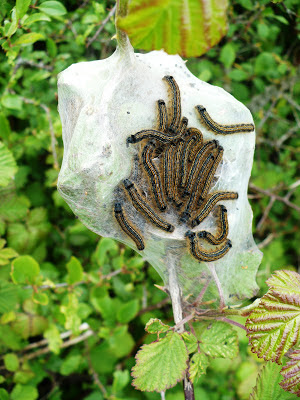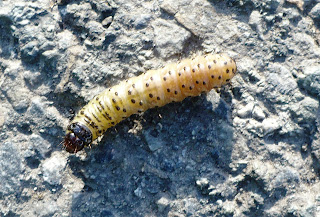This blog may help people explore some of the 'hidden' issues involved in certain media treatments of environmental and scientific issues. Using personal digital images, it's also intended to emphasise seasonal (and other) changes in natural history of the Swansea (South Wales) area. The material should help participants in field-based modules and people generally interested in the natural world. The views are wholly those of the author.
Friday, 31 May 2013
Wednesday, 29 May 2013
Seeing the Changes 574
More changeable weather. Noted what looked like ancient sun-cracking in the mud on the collapsed banks of the river Loughor. There was also lots of relatively large fungi on horse droppings. Thrift (Armeria maritima) was in bud there. I also noted a Green-veined white butterfly (Artogeia napi) feeding and a writhing mass of Lackey moth (Malacosoma neustria) larvae on a web. In Loughor, Herb Bennet (Geum urbanum) and Marsh willowherb (Epilobium palustre) were flowering.
Sunday, 26 May 2013
Palm-oiled and Logged out?
Areas of rain forest in Sumatra and other Indonesian locations are being decimated by logging for paper mills and replacing the forests with palm oil plantations (http://www.guardian.co.uk/environment/2013/may/26/tigers-stronghold-sumatra-poachers?INTCMP=SRCH). Most of the activity to driven by western demands for materials with little or no regard for the endangered animal and plant life in the area including Orang-utans, Sumatran tigers and rhinoceros. There are even suggestions that fires are started deliberately in these areas to speed up the deforestation process.
Seeing the Changes 573
At Oxwich, there was lots of Mouse-ear hawkweed (Hieracium pilosella) and Kidney vetch (Anthyllis vulneraria) in flower. There was also the first bloom of a Stone bramble (Rubus saxatilis). In the dunes, there was lots of solitary bee activity and, in the rock pools, located Grey chiton (Lepidochitona cinerea).
Saturday, 25 May 2013
Friday, 24 May 2013
A Lesser Consideration?
It has been revealed that a colony of endangered Lesser black-backed gulls (Larus fuscus) has been subject to a culling order by English Nature (and its predecessors) since the 1970s (http://www.guardian.co.uk/environment/2013/may/23/conservation-agency-approved-cull-endangered-birds?INTCMP=SRCH). The colony is near the Bowlands Fells in Lancashire and the original excuse for the cull was potential contamination of the local reservoir by bird droppings (a highly contentious excuse, anyhow). It has now been claimed that the real reason for the cull's approval was the location of the circa 9500 hectare Abbeystead estate, largely maintained for grouse shooting. There is a claim that Lesser black-backs sometimes consume grouse eggs (hardly remarkable as this species, like many others, is opportunistic in its feeding habitats and the grouse eggs would constitute an artificially concentrated food source). It does seem strange that English Nature appeared to ignore one of its primary purposes (i.e. conservation of endangered species) over an extended period. Perhaps they thought it more important to stay on good terms with the land-owner?
Wednesday, 22 May 2013
Seeing the Changes 571
Stuff seems to be coming out in a rush. In Loughor, Sulphur cinquefoil (Potentilla recta) and White stonecrop (Sedum album) were in flower. In Bynea, Cut-leaved cranesbill (Geranium dissectum), Smooth sow-thistle (Sonchus oleraceus), Field forgetmenot (Myosotis arvensis), Common field speedwell (Veronica persica) and Germander speedwell (Veronica chamaedryas) all made an appearance.
Ever Fewer-More Boring?
An analysis of 'tens of millions of observations from volunteers' over the last 50 years (http://www.guardian.co.uk/environment/2013/may/21/uk-species-struggling-wildlife) has confirmed that much of the UK's wildlife is in serious decline. Struggling species (60% of those analysed were showing serious declines) range from the Freshwater pearl mussel, a variety of insects (including the Garden tiger moth), Atlantic salmon, Hedgehogs, Greater horseshoe bats and Lesser spotted woodpeckers. That is not to mention the plants on which some of these animals (diestly or indirectly) rely! A few species (like the Red kite and the European otter) seem to be doing well, largely as a result of serious and continued conservation efforts over extended periods (including changes in the Law) but most of the endangered species suffer from habitat destruction, pollution and/or disturbance. The analysis largely blames intense agriculture (although others will argue that it is needed to feed increased human populations and to facilitate the production of some 'biofuels') but urbanisation (a process likely to be intensified by a drive to create millions of 'affordable homes') and climate change must also play roles. Even a greater human participation in 'outdoor activities' (needed for our health) including even studying natural history can make it more difficult for certain species. And don't start me on gardeners with their introduced alien species and the release of feral 'pets'!
Tuesday, 21 May 2013
Sunday, 19 May 2013
Saturday, 18 May 2013
Thursday, 16 May 2013
In the Backyard: Climate Change Special
Given the level of US opposition to the ideas of anthropogenic (human produced) climate change, it is somewhat ironic that the American village of Newtok in Alaska is on the verge of being washed away (www.guardian.co.uk/environment/interactive/2013/may/13/newtok-alaska-climate-change-refugees). It will be gone by 2017. It is even more remarkable that the event cannot even be ameliorated by monies from the US disasters fund which is reserved for hurricanes, earthquakes, bush fires, whirlwinds etc. Melting of the permafrost and the loss of land to increased volumes of water coming down rivers appear not to count at present.
Sunday, 12 May 2013
Saturday, 11 May 2013
Ducking and Diving?
Studies by the WWT have suggested that declines in the numbers of Tufted ducks, Goosanders and Goldeneyes migrating to over-winter in the UK are consequences of climate change (http://www.bbc.co.uk/news/science-environment-22484907). It seems that warmer winters in Scandinavia have persuaded some of these water birds to resist migration (an energetically demanding activity).
Working on the Greenhouse?
News that the atmospheric levels of carbon dioxide have exceeded 400 parts per million in the measurements obtained at the Mauna Loa observatory on the remote 'Big Island' of Hawaii (http://www.esrl.noaa.gov/gmd/ccgg/trends/) are probably 'ceremonial' rather than scientifically meaningful (like a 'triple dip recession'). The attainment of the figure so early, however, is a clear indication that attempts to contain the release of 'climate changing gases' has been spectacularly ineffective.
Friday, 10 May 2013
Subscribe to:
Comments (Atom)
-
I n the UK and US, a pparently popular and successful vegan/vegetarian restaurants are reportedly closing or adding meat to their menus ( ...
-
Early ripening fruit may seem convenient but some folk think it confirms environmental stress. There's also a possibility th...



+lateral+down+Loughor.JPG)











+lateral+Oxwich.JPG)


+Skomer+Pembrokeshire.tif)







+running+North+Gower.jpg)

+lateral+Loughor.jpg)














+Blackpill.jpg)
+Bynea.JPG)
+male+swimming.jpg)





%20mating%20NWCW.jpg)

